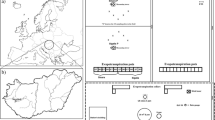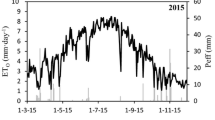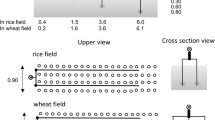Summary
A water balance model, incorporating the influence of water deficit during vegetative growth on depth of water extraction, was used to calculate stress days from soybean irrigation experiments. A stress day was defined as a day when soil water deficit exceeded 60% of the capacity of the current root zone. Using data from 17 experimental treatments the influence of water deficits on yield and leaf area were ascertained. Soybeans were most sensitive to water stress during flowering and pod filling, and stress just prior to and during flowering increased the effect of stress during pod filling. For example, in the cultivar Ruse, stress during pod filling reduced yield by 21 kg ha−1 (stress day)−1 if there was no previous stress. If there had been 10 days of stress during vegetative growth, yield in pod filling was reduced by 52 kg ha−1 (stress day)−1. Yield was expressed as a function of stress days. Using this function and past meteorological data in the water balance model, it was found by simulation that from an allocation of 960 thousand cubic meters of water, the greatest yields were obtained by growing 100 ha of soybeans and irrigating at 60% soil water deficit. With progressively larger areas the water allocation was exhausted before the end of the season in an increasing number of years. However, the larger area compensated for the reduced yield and net returns averaged over 20 years were greatest when 160 ha were grown. Increasing the deficit for irrigation in order to make the water last longer increased the yield in dry years when the allocation was exhausted prematurely, but when averaged over 20 years, this effect was outweighed by loss of yield in the other years.
Similar content being viewed by others
References
Boyer JS (1970) Cell enlargement and metabolic rates in corn, soybean and sunflower at various leaf water potentials. Plant Physiol 46:233
Burch GJ, Smith RCG, Mason WK (1978) Agronomic and physiological responses of soybean and sorghum crops to water deficits. II. Crop evaporation, soil water depletion and root distribution. Aust J Plant Physiol 5:169
Constable GA, Hearn AB (1978) Agronomic and physiological responses of soybean and sorghum crops to water deficits. I. Growth, development and yield. Aust J Plant Physiol 5:159
Constable GA, Hearn AB (1980) Irrigation for crops in a sub-humid environment. I. The effect of irrigation on the growth and yield of soybeans Irrig Sci 2:1
Cull PO, Smith RCG, McCaffery K (1981) Irrigation scheduling of cotton in a climate with uncertain rainfall. II. Development and application of a model for irrigation scheduling. Irrig Sci 2:141
De Bruyn LP, De Jager JM (1978) A meteorological approach to the identification of drought sensitive periods in field crops. Agric Meteorol 19:35–40
List RJ (1966) Smithsonian meteorological tables. Smithsonian Institution, Washington, p 418
Mason WK (1979) The irrigation scheduling of soybeans. Ph D Thesis, University of New England Armidale Australia
Mason WK, Counstable GA, Smith RCG (1980) Irrigation for crops in a sub-humid environment. II. Water requirements of soybeans. Irrig Sci 2:13
Mason WK, Smith RCG (1981a) Irrigation for crops in a sub-humid environment. III. An irrigation scheduling model for predicting soybeans water use and crop yield. Irrig Sci 2:89
Mason WK, Smith RCG (1981b) Irrigation for crops in a sub-humid environment. IV. Analysis of current irrigation practice of soybeans and the potential for improved efficiency. Irrig Sci 2:103
Priestly LHB, Taylor RJ (1972) On the assessment of surface heat flux and evaporation using large-scale parameters. Mon Weather Rev 100:81
Rawson HM, Turner NC, Begg JE (1978) Agronomic and physiological responses of soybean and sorghum crops to water deficits. III. Photosynthesis, transpiration and water use efficiency of leaves. Aust J Plant Physiol 5:195
Ritchie JT (1972) Model for predicting evaporation from a row crop with incomplete cover. Water Resour Res 8:1204
Shibles RM, Anderson IC, Gibson AH (1975) Soybeans. In: Evans LT (ed) Crop physiology: Some case histories. Cambridge University Press, London New York, p 151–189
Turner NC, Begg JE, Rawson HM, English SD, Hearn AB (1978) Agronomic and physiological responses of soybean and sorghum crops to water deficits. III. Components of leaf water potential, leaf conductance, 14CO 2photosynthesis, and adaptation to water deficits. Aust J Plant Physiol 5:179
Author information
Authors and Affiliations
Rights and permissions
About this article
Cite this article
Hearn, A.B., Constable, G.A. Irrigation for crops in a sub-humid environment. Irrig Sci 3, 1–15 (1981). https://doi.org/10.1007/BF00251379
Received:
Issue Date:
DOI: https://doi.org/10.1007/BF00251379




